Photography in Grand Teton – Tips for Travel Photographers
by Alex W.
Are you a travel photographer looking for a healthy dose of panoramic peaks and valleys? Well, photography in Grand Teton could offer you exactly what you’re craving.
Grand Teton has long been considered an exceptional destination for capturing the natural beauty of the Midwest.
Located just south of the country’s first national park, Yellowstone, Teton boasts a whopping 310,000-acres of immaculate alpine lakes, high-altitude summits, winding rivers, and lush meadows.
The park’s namesake mountain range, the Teton Range, stretches for more than 40 miles through the state of Wyoming, making a bold and memorable appearance at the heart of the park.
Most visitors will drop by to photograph Grand Teton en-route to Yellowstone, but we believe this incredible landscape deserves its very own spot on your photography bucket list. To kickstart your adventure, we put together a list of tips and tricks to photographing the Tetons.
Looking for more travel photography destinations? Check out our guide to photography in Yosemite and photography in Banff here!
Contents
Top Spots for Photography in Grand Teton
Schwabacher Landing
Schwabacher Landing can be summarized in a single word – Drama. not the ‘I accidentally formatted my SD card’ kind of drama, but the kind that inspires you to roll out of bed well before the sun.
Theatrical summits, picture-perfect reflections, alpenglow, and the occasional Moose – pick your preference – Schwabacher offers all of these at the meager cost of a 10-minute walk from the car.
Despite the notoriety of this cherished location, some visitors will inadvertently miss the look for a relatively inconspicuous sign at the edge of a gravel access road that reads ‘Schwabacher’s Landing Road.’
Take the road until it dead-ends at a parking lot. From there, a path leads along the shore of the Snake River, offering an array of striking vistas and vantage points to photograph. Don’t be tempted to snooze your alarm, Schwabacher is incredibly popular at sunrise and photographers will line the footpath, eager to capture golden hour over the Tetons.
This is the quintessential shot that everybody thinks of landscape photography in Grand Teton, and there’s a good reason for that!
Snake River Overlook
When it comes to crafting epic compositions, there’s nothing better than well-defined leading lines. The Snake River Overlook is a natural masterpiece crafted by Mother Nature.
The overlook features a spectacular view of the Snake River as it winds its way toward the park’s renowned namesake summits – a compositional dream for the landscape photographer.
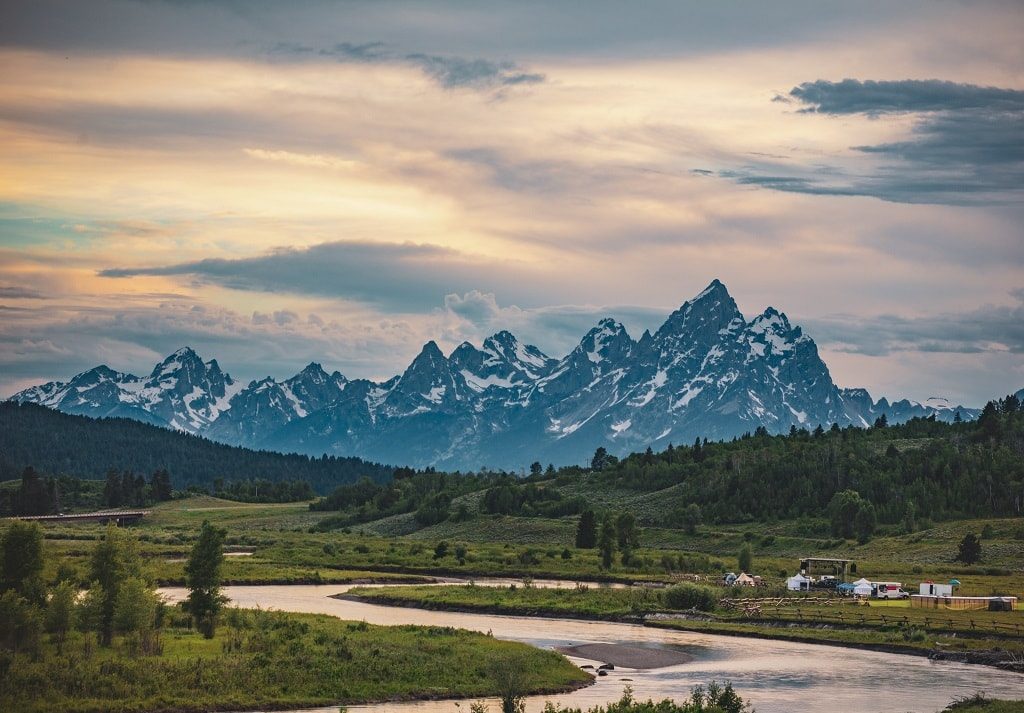
Rumor has it, this incredible vantage point was first photographed and made famous by the legendary Ansel Adams. In the 1940s, Adams leveraged this striking vista of the Snake River Valley to lobby for the preservation and protection of what is now known as Grand Teton National Park.
It’s worth noting that you won’t share the same view as Adam’s 70-year-old photograph – Tall trees have since partially obstructed the view. However, with a little ingenuity, it’s still entirely possible to capture the scale and grandeur of the Snake River Valley.
Mormon Row
In 1862, good ol’ “Honest Abe” signed the Homestead Act allowing folks to migrate West and claim their 160-acres of free public land. A group of Mormons from Salt Lake City took him up on his offer, setting up 27 homesteads at the base of the Teton Range.
There’s no denying that the town of Grovont, which is now referred to as ‘Mormon Row,’ had some killer views.
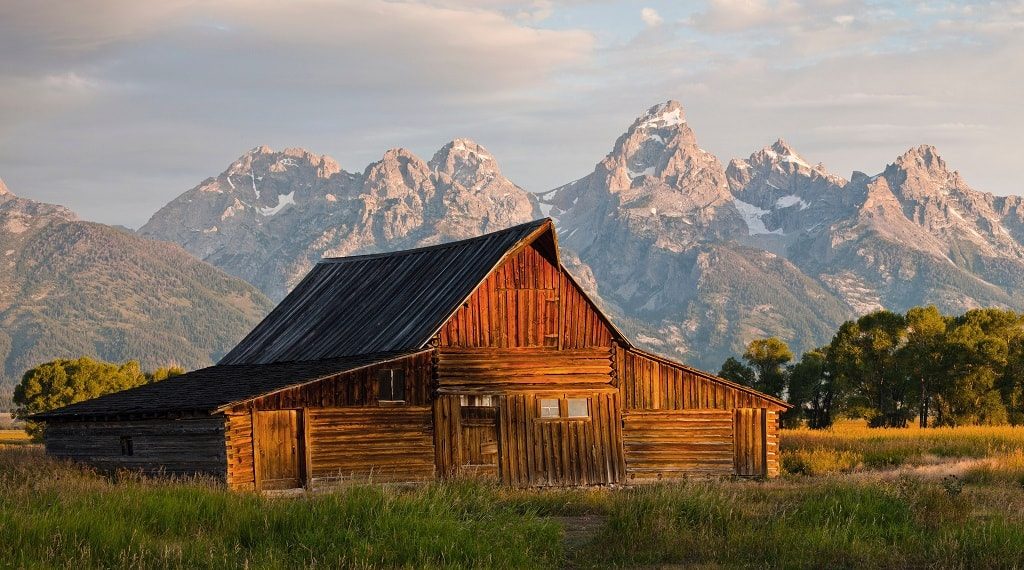
Despite the harsh climate and farming conditions, the people of Grovont found a way to survive and thrive in Jackson Hole Valley until the mid-1900s, when Grand Teton National Park acquired the land. Still, this slice of rural history remains on the National Register of Historic places and is a highly revered destination for travelers and photographers alike.
The most photographed barns on Mormon Row are the John Moulton Barn and the T.A. Moulton Barn. The iconic snow-capped summits of the Teton Range construct an idyllic backdrop for these historic homesteads. As the sun sets, beautiful golden light can be seen dancing over the weathered wooden beams of the Moulton Barns, illuminating the peaks of the surrounding summits.
Oxbow Bend
Arguably the most scenic turnout in Grand Teton, Oxbow Bend is where photographers go to capture the grandiose Mount Moran reflecting in the Snake River.
The best time to visit Oxbow Bend is at sunrise when the water is calm, and Mount Moran is outfitted in brilliant pink and purple hues. Or, if you’re willing to gamble with the weather, visit during Autumn when the golden glow of the surrounding aspens creates an incredible contrast to the vivid blue Snake River.
Oxbow Bend is just a few miles from both the Moran Junction entrance station and Jackson Lake Junction.
Blacktail Pond Overlook
From the main road, this overlook certainly doesn’t earn any awards for wow-factor. But don’t let Blacktail’s lackluster curb appeal fool you.
While the average visitor might drive right by, wildlife photographers have long-considered Blacktail Ponds to be a diamond in the rough for wildlife viewing.
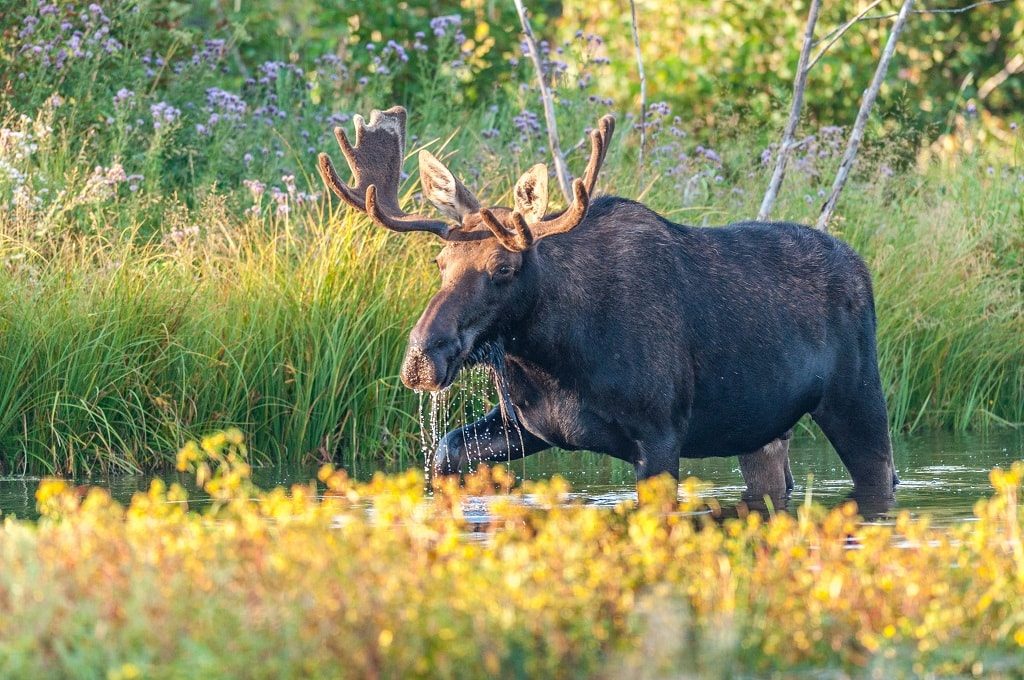
Black Bear, Deer, Marmots, Elk, Bison, Beaver, and Moose all frequent the Blacktail Ponds. And, because the overlook doesn’t make it to the top of many ‘must-see’ lists, wildlife tends to linger, undisturbed by tourists.
Also, it’s worth mentioning that Blacktail isn’t just a watering hole for wildlife. The view from the lookout is incredibly scenic and features the same craggy, snow-capped summits as more reputable overlooks.
To increase your odds of photographing wildlife, visit Blacktail Ponds at dusk or dawn and bring along some binoculars so you know where to point your telephoto lens.
Scenic Drives in Grand Teton
Grand Teton is notorious for scenic vistas. But generally, between each spectacular panorama is an equally impressive drive.
The Inner Park Loop, Jenny Lake Loop, and Signal Mountain Road are all crowd-favorites that feature miles of classic Teton views, like the craggy Cathedral Group, glacial-fed Jenny Lake, and the surrounding valley.
If you brought along a telephoto lens, one of these scenic drives offers the perfect opportunity to capture the grandeur of the 40-mile-long Teton range towering over the surrounding landscape.
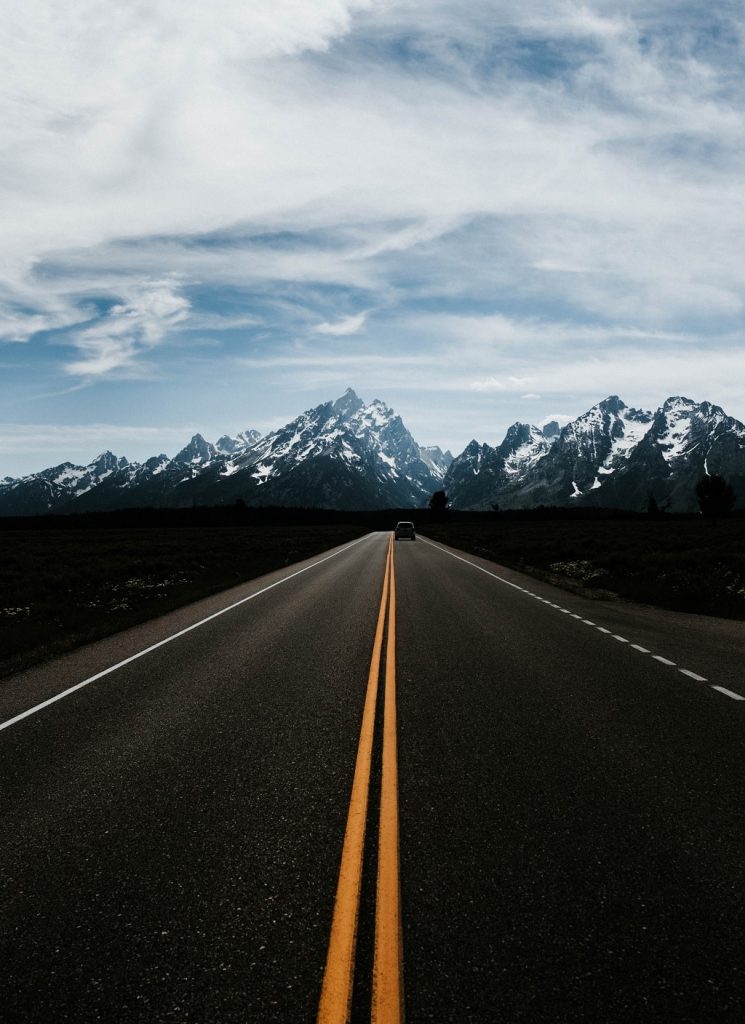
Off the Beaten Path
Aside from awe-inspiring vistas, Teton houses some of the most incredible hiking trails in the Midwest.
If you’re eager to ditch the crowds and hit the trail, there are a few footpaths that should be on your radar.
The Signal Mountain trail is a moderate, 6.8-mile trek that climbs to the summit of 7,700-foot Signal Mountain. As you can imagine, the views from the top are memorable, to say the least. As you climb, the entire Teton Range will unfold before your eyes. It may be a pain to pack your heavier lenses, but the extra effort comes with a huge payoff.
Jenny Lake gets a lot of love from visitors, but if you don’t want to bump elbows with other photographers, consider hiking the four-mile loop around Taggart Lake. The trail, which only climbs a few hundred feet, won’t take your breath away in a literal. But in terms of visual beauty, Taggart is hard to beat. Not to mention, in the Fall, this aspen-lined trail is sure to make all of your leaf-peeping dreams come true.
When to Visit Grand Teton National Park
The gates don’t close in Grand Teton, and the park has a reputation for being the ideal, all-seasons destination.
However, the best time to visit largely depends on what you’re hoping to achieve with your Grand Teton photography.
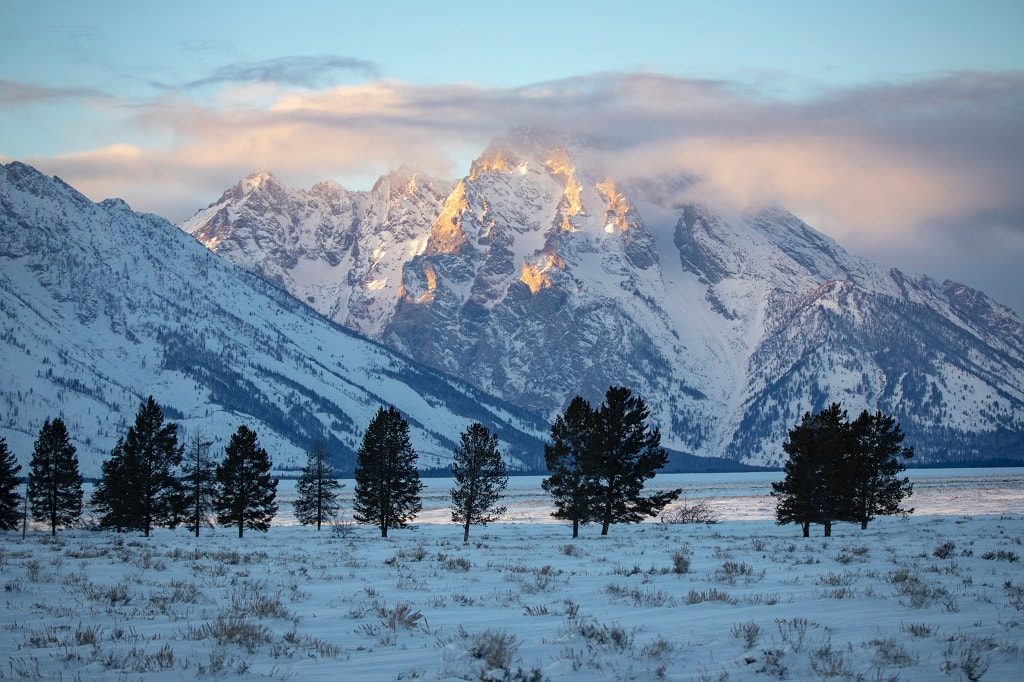
Fall – September to October
Hoping to avoid the crowds, but not ready to endure winter weather? Fall strikes the perfect balance between modest weather and increased accessibility.
Less snowfall means there are more scenic roads and hiking trails to explore. During ‘peak’ fall foliage, the park is bursting with vibrant colors, adding a little extra ambiance to an already-incredible landscape.
Winter – October to early May
Snow accumulates quickly and the landscape transforms into a winter-wonderland. It’s not uncommon for temps to drop into single digits, so make sure you pack extra batteries, layers, and fortitude during winter months.
Also, keep in mind that some park roads and trails will be closed, so pre-planning is a must if visiting Grand Teton in winter.
Spring – April to May
Spring in the Tetons can look a lot like Winter 2.0. Winter tends to linger a bit longer in the Tetons, and it’s not uncommon for snow to cling to higher elevations and surround popular parking lots and roadways.
Still, for photographers looking for a less-crowded views of snow-capped summits, Spring can’t be beat. Keep an eye on the weather forecast, there’s generally a timeframe before Summer is in full swing, where the park will begin to thaw but visitation is still low.
Summer – June to August
So, you probably won’t beat the crowds, but Summer offers some of the very best weather for early-morning and overnight photo expeditions.
The Tetons certainly aren’t lacking in mid-summer storms, but generally the weather is a lot more mild and predictable, and scenic roads and trails are fully accessible.
Recommended Gear for Photography in Grand Teton
Lens Recommendations
Telephoto Lens
Teton might be one of the few places where a mid-range lens (50mm to 70mm) or telephoto (70mm to 200mm) will outshine a wide angle lens.
If you’re hoping to capture the true scale of the Teton summits, you’ll want to employ a longer lens to compress, or pull the peaks in the background closer to the foreground.
A telephoto is also ideal for photographing wildlife at a safe distance and getting a closer look at the intimate textures and crags of the Teton Range.
We recommend all landscape photographers consider a telephoto lens, and our favorite for DSLR owners is the highly rated Tamron 70-200mm f/2.8 Di VC USD G2.
-
Tamron SP 70-200mm f/2.8 Di VC USD G2 Lens for Canon EF...
- INCLUDES: Tamron SP 70-200mm f/2.8 Di VC USD G2 Lens + Tamron TAP-in Console for Canon + AirBag Packable Bag and Camera Insert + SanDisk 64GB C10 Ultra UHS-I SDXC Memory Card + Altura Photo Mini Tripod with Pistol Grip + Altura Photo Rapid Fire Wrist Strap + Altura Photo Hard-Shell Case + Altura Photo Accessory Kit + 3 Sizes MagicFiber Microfiber Lens Pouch
- A POPULAR TELEPHOTO ZOOM for a variety of shooting applications, this lens is characterized by its bright f/2.8 constant maximum aperture, as well as sophisticated optical and physical designs.
Wide-Angle Lens
That’s not to say that if you have a wide-angle (17mm to 35mm) you should leave it at home. After all, a wide-angle lens is pretty much a staple in every landscape photographers kit.
If you’re hanging out at Schwabacher Landing, for example, you can use a wide-angle to capture unique foreground elements (i.e. tall grass, flowers) to create a compelling image.
Our favorite, for DSLR owners at least, is another Tamron. This time, the Tamron 15-30mm f/2.8 Di VC USD G2.
-
Tamron SP 15-30mm f/2.8 Di VC USD G2 Lens for Nikon F +...
- INCLUDES: Tamron SP 15-30mm f/2.8 Di VC USD G2 Lens for Nikon F + Tamron Tap-in-console For Nikon + AirBag Packable Bag and Camera Insert + Altura Photo Mini Tripod with Pistol Grip + Altura Photo Rapid Fire Wrist Strap + Altura Photo Hard-Shell Case + Altura Photo Accessory Kit + 3 Sizes MagicFiber Microfiber Lens Pouch
- COVERING a versatile range of ultra wide-angle focal lengths, the Tamron EF-mount SP 15-30mm f/2.8 Di VC USD G2 enhances this wide zoom with sophisticated optics, focusing, and image stabilization.
Misc. Items
There are a few other items you should seriously consider taking when off photographing Grand Teton. All of these items feature in our Ultimate Guide to Travel Photography Gear as well!
Extra batteries: There are a few places to drop in and recharge your battery if you need to, but do you really want to leave the dreamy shore of the Snake River to sit inside and recharge? Bring along enough battery power to get you through a full day (and night) of shooting – you won’t regret it.
Polarizing Filter: With so many pristine mountain lakes and ponds to photograph, a polarizing filter is a must. Polarizing filters will clean up reflections, balance out bright blue skies, and give your images a little extra saturation.
Tripod: Especially when working with a telephoto lens or at low-light, hand-shake is inevitable. To keep your photos of the Tetons pin-sharp, using a tripod is a must.
Struggling to choose a suitable tripod? Check out our handy guide on buying a tripod to help you make the decision.
Read More…
Ultimate Guide to Landscape Photography Pt 1: Gear
The Best Astrophotography Lenses
5 Must Buy Lenses for your Canon
7 Reasons You Need a Nifty Fifty Lens
 |
 |
 |
 |

About Alex W.
Alex is the owner and lead writer for Click and Learn Photography. An avid landscape, equine, and pet photographer living and working in the beautiful Lake District, UK, Alex has had his work featured in a number of high profile publications, including the Take a View Landscape Photographer of the Year, Outdoor Photographer of the Year, and Amateur Photographer Magazine.
Thoughts on "Photography in Grand Teton – Tips for Travel Photographers"
 |
 |
 |
 |
You can Get FREE Gifts. Furthermore, Free Items here. Disable Ad Blocker to receive them all.
Once done, hit anything below
 |
 |
 |
 |


